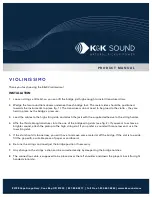
( ) Adjust the trim pots P 2 on each V V 1 such that the longest reverb (" Reverb
I and II" turned on) suits your personal taste. Our recommendation: centre of
rotation.
( ) Set both treble controls P 3 on V V 1 (top) and Me bass controls P 4 (centre)
to the centre of rotation. Later on, you may want to re-adjust these controls to
match the organ sound to the room acoustics.
( ) Set the trim pots P 5 on V V 1 (bottom) for the highest desired volume from
your speaker when the swell pedal is fully depressed and when you play with "full
organ":
( ) Set the trim pot P1 (Output) on the Wersivoice circuit board WV 7 to the
centre of rotation.
( ) Find the position on P 2 (Input) on WV 7 where distortion occurs using many
fixed stops. Then, back off the volume until the distortion disappears.
( ) Now adjust P 1 (Output) such that the volume is the same in both positions of
the switch "Fixed Stops to Wersivoice" (using stops of the upper manual).
( ) Hold a full chord, using fixed stops in the upper manual. Turn on the rocker
switch "Fast/Chorale": The vibrato should be slow now (chorale speed).
( ) Turn the switch "Fast/Chorale" off again. The vibrato speed should increase
slowly until it reaches the fast (normal) speed. The Wersivoice simulates the
inertial speed-up of mechanical rotators.
( ) Turn on (down) the rocker switch "Speedshift Slow/Fast": When the speed is
changed now from slow to fast the speedshift takes place instantaneously (no
longer simulating any mechanical inertia). The speed change from fast to slow
(chorale) remains sudden, independent of the setting of the switch "Speedshift
Slow/Fast':
( ) Turn on the switch "Heavy" (also called "Celeste"). The intensity of the vibrato
should increase.
( ) Turn on the switch "Soft" only (also called "Chorus"). The vibrato becomes
less intense.
( ) Turn on both "Heavy" and "Soft": The result is an intensified vibrato (like the
one you hear when holding your ear very close to a rotating speaker). Thus
"ultra-heavy "vibrato is disabled automatically (and reduced to "normal heavy") at
the chorale speed.
( ) Turn on the switch "Whirl/Choir" only. The Wersivoice is now in its voice-
multiplying mode (also called string orchestra mode). The incoming voices
(coming from single instruments) are transformed into sets or choirs of voices.
The two intensity switches perform similar duties as in the "Whirl" mode. The
"Fast/Chorale" switch, however, is disabled. For more details, refer to the manual
AM 4 65 "Wersivoice".
Testing of the Swell Indicator
( ) Push the connector onto the pins on the swell indicator LA 1.
( ) Set the swell pedal to maximum volume, fully depressed. The LED's of the
swell indicator should light up.
( ) Adjust the trim pot P 1 on the board LA 1 such that the last (red) diode just
lights up with a fully depressed pedal.
3.15 Testing of the Piano, Couplers and Wersidata
Programming
The installation, wiring, and testing of the remaining building blocks are described
in the respective assembly manuals.
4 Final Steps
When you reach this chapter you have completed a considerable amount of
work. We congratulate you for this achievement.
But, please, tome your haste and spend some time for the final cleanup. Inspect
the instrument for loose particles and tools. Use a vacuum cleaner to suck up the
remaining debris. (Some small strands of wire have a tendency to lodge
somewhere between terminals and components where they can cause the
AM 079 (Part)
12









































